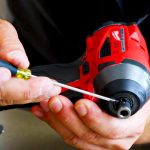Table of Contents
Whether you’re a homeowner or a professional, a drill is one of the most versatile and essential tools to have in your tool kit. And, because drill bits come in a variety of different shapes and sizes, you’ll need to know which ones are best suited for which tasks.
The traditional drill bit can be used for most jobs, but there are occasions when a split-point drill bit is an ideal solution. A split-point drill bit is a high-speed drill bit that is noted for its precision and efficiency. With a 135-degree cutting angle, split point drill bits feature two extra cutting blades on the chisel edge so that they would need less drilling pressure while operating. It’s perfect for drilling into metal and other hard materials without causing damage to the surrounding area. Furthermore, the three grooves on the shaft of the split point bit allow dust and debris to escape, hence, reducing any snags.
How Does A Split Point Bit Work?
A split point bit is designed to cut through metals and comes with 135 degrees angle points. Two extra edges are ground into the chisel edge of the split tip drill, making the head of the drill one continuous cutting edge. The split point is also self-centering, which means that the drill begins cutting as soon as it makes contact with the material.
Point Angle Of A Split Point Bit
The ability and effectiveness of a drill bit to drill into various materials are determined by its point angle. The greater the angle, the better the bit’s capacity to drill through tougher materials. A split-point drill bit has a 135-degree cutting angle. Due to its 135-degree cutting edge, this bit has a flatter edge and a larger chisel, which is ideal for drilling into hard materials like copper and stainless steel. A split point bit usually has a flatteringing point that reduces vibration, providing excellent drilling accuracy and stability.

Split Point Drill Bit vs Standard Drill Bits
A collection of drill bits of varying sizes is essential for your woodshop or home. Having multiple drill bits, including the flexible split-point bit, would make your woodworking and other jobs way easier. Let’s see what makes the split point drill bit different than any other standard drill bit.
- The standard drill bit is equipped with a 118-degree of point angle, whereas the split point drill bit uses 135 degrees of point angle.
- The standard drill bit’s shaft features two spurs, which are curving grooves that push debris out of the hole while drilling. The split point drill bit’s shaft has three grooves that remove debris out of the way, allowing you to drill holes quicker with fewer snags.
- A standard bit’s tip is smooth, and on the other hand, the split point drill bit has a grooved tip rather than a smooth one.
- Standard drill bits have a tendency to drift away when drilling into any substance, so you’ll need a center punch to get it stable. However, split-point drill bits offer more stability and prevent the drill from wandering because of the additional edges.
- Due to the angled tip, the standard drill bits are suitable for drilling into soft materials, and the split point drill bits are perfect for powering through hard materials.

When Do You Need a Split Point Drill Bit?
There are so many choices of drill bits in the market, each suitable for different kinds of applications. Like any other drill bit, the split point drill bit has a wide variety of applications that it shines in. Besides, working with hardwoods and other rare and precious woods necessitates the use of a split point drill bit.
- Unlike other regular drill bits, split point drill bits are more heat-resistant. Since drilling metal generates greater heat and friction, a split point drill is more durable when working with metal. This heat-resistant attribute makes sure the split-point drill bit’s grooves and tips don’t wear off easily.
- Along with cutting through dense alloy steels, stainless steel, and aluminum, a split-point drill bit can power through other substances like hardwood as well.
- When it comes to working with curve-shaped materials, the regular drill bits tend to wander across the surface. But split-point drill bits work really well with curve-shaped materials as they do not walk on the material or gouge it.
- Since the grooves of the split point drill bit allow debris to lift out of the material and eliminate snags, it’s ideal for making smaller, more precise, and cleaner holes.
- A split-point drill bit is ideal when dealing with slippery surfaces like metal pipes.
- If you’re using a cordless drill and want more stability in your application, then split point drill bits would be the best choice.
Final Verdict
A split point bit is a great option for both home and professional drilling. Split point drill bits are designed in a way so that you can save time when producing a center punch. However, don’t try to sharpen the drill bits as the edges have a tendency to break while sharpening. Once the bits get dull it’s recommended to buy a new set. Besides, compared to regular drill bits, split point drill bits don’t wear off or get dull that easily.










Leave a Comment